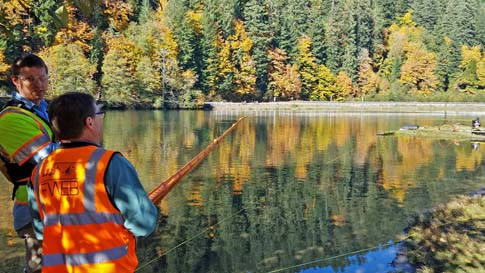Related News
Related News
-
Let's Talk Turkey. Is your family ready for winter?
We're heading into the holidays, but that also means snow, ice, and not-so-nice weather might be in the forecast. Here are some tips to prepare in advance.
Find Out More -
EWEB Hosts Annual Spill Drill to Protect McKenzie River
EWEB led emergency responders in its annual “spill drill” on the McKenzie River on Wednesday, Oct. 15, at the Trail Bridge Campground.
Find Out More -
A day in the life: Monitoring water quality throughout the McKenzie Watershed
Follow Senior Environmental Specialist David Donahue as he collects water quality samples from throughout the watershed as part of EWEB's early warning system for threats to Eugene's drinking water.
Find Out More -
EWEB Partners with Eugene School District 4J to Celebrate New Kennedy Middle School Emergency Water Station Site
Hundreds of attendees practiced filling up water containers at Saturday's demonstration event.
Find Out More -
Electric Projects underway in North & South Eugene
Underground lines and disaster-resilient power poles are part of EWEB’s infrastructure upgrade near Eugene’s largest natural resource area.
Find Out More -
Quartz Creek: Setting the Stage for Floodplain Restoration
The project resets the floodplain along 1.8 miles of a formerly channelized creek to improve water quality, fish habitat and natural disaster resiliency.
Find Out More -
Pure Water Partners: 5 Years of Regeneration
As EWEB and the Pure Water Partners observe the fifth anniversary of the Holiday Farm Fire, we celebrate major milestones in the watershed's recovery and check back in with PWP landowners who still have a lot of work ahead as they continue to rebuild their lives.
Find Out More -
Join the Pledge to Prepare
When you think about getting ready for an emergency, you probably have questions. You aren't alone. Preparing for emergencies can be overwhelming, which is why EWEB has put together a 12-month program to help you and your family get two weeks ready.
Find Out More -
You can’t predict the next disaster, but you can prepare
The earthquake lasted less than a minute. But now the power’s out. The tap runs dry. Cell service is spotty. Would you be ready?
Find Out More -
EWEB Celebrates Operators on the 75th Anniversary of the Hayden Bridge Filtration Plant
Learn more about the Water Treatment Plant Operators who have kept the Hayden Bridge Filtration Plant running for the last 75 years.
Find Out More -
NASA partners with EWEB to assess wildfire impacts to drinking water
NASA's Earth Information Center shares a new video detailing how EWEB's Drinking Water Source Protection work is advising new research tools
Find Out More -
EWEB prepares for wildfire season with risk mitigation measures
EWEB is building a more resilient electric system to weather various types of disasters, from wildfire to winter storms.
Find Out More -
EWEB environmental specialist wins prestigious awards for publication
Article recounting EWEB’s efforts to protect the McKenzie River after Holiday Farm Fire earns national recognition
Find Out More -
Last Call for EWEB/Lane County Septic Grants
Holiday Farm Fire recovery program now eligible for businesses, residential property owners who purchased post-fire, to cover inspection costs and new construction
Find Out More -
EWEB Pilots New Line Safety Program for 4th graders.
This year, EWEB is ramping up power line safety for children, specifically 4th graders.
Find Out More - Show More
Spill Drill Tests McKenzie River Emergency Response
October 31, 2017

More than 30 emergency responders from multiple local agencies conducted a live "spill drill" in late October on the McKenzie River above Leaburg Dam.
Participants practiced containing a fictitious fuel spill using the McKenzie Watershed Emergency Response System (MWERS). They set up fast-water containment booms, deployed oil recovery equipment and performed other tasks to minimize the spread of the oil in order to protect the McKenzie River, which supplies drinking water to the nearly 200,000 residents of Eugene.
The joint drill was primarily organized by the EWEB, McKenzie Fire & Rescue and the Eugene Springfield Fire Hazmat Team to familiarize first responders with MWERS. Other agencies included the Springfield Utility Board, the city of Springfield, the Lane County Sheriff's Office, the U.S. Forest Service, and the Corps of Engineers.
"Interagency drills like this are extremely valuable because it allows us to refresh and hone our skills in deploying spill response equipment that we rarely have the opportunity to use and then test these pre-planned response strategies," said Karl Morgenstern, EWEB's Source Protection Supervisor.
Refreshing those skills required to quickly and efficiently deploy the booms is something all the agencies agree is important to do on a regular basis. While some are familiar with the process, boom deployment is complicated even during good weather, so having time to practice together as a team improves the likelihood of success during an real spill event.
"The real value is working together so we know each other and we know the resources and skills each agency can bring to a response before we all show up at an actual incident," Morgenstern said.
Responders were reminded of the precarious position of the McKenzie River in relation to Highway 126 last June, when a tanker truck carrying about 11,000 gallons of gasoline crashed on the highway about one mile east of Leaburg. The crash occurred just 1,500 feet from the river. Fortunately, none of the roughly 1,700 gallons of fuel spilled entered any of the river's tributaries.
The MWERS emergency response system was created in 2002 by EWEB and McKenzie Fire & Rescue Fire to assist first responders in the event of a hazardous materials spill or other emergency that threatens the water quality of the McKenzie River, Eugene's sole source of drinking water. The system uses detailed mapping and computer technology to give emergency crews information and instructions for containing spills in specific segments of the river. In addition, three fully-equipped interagency response trailers are staged throughout the McKenzie Watershed for rapid response to a spill.

